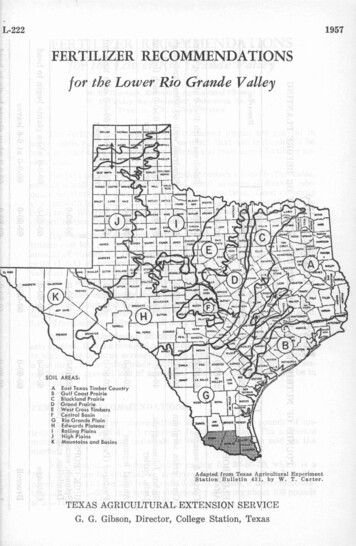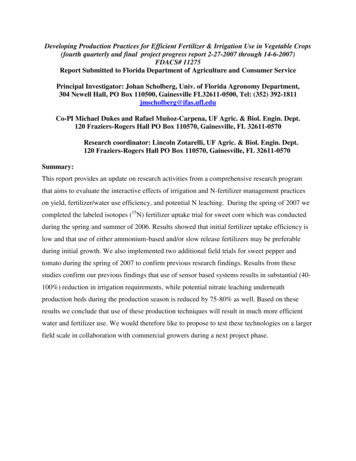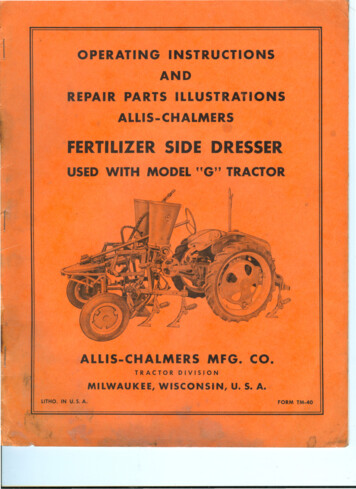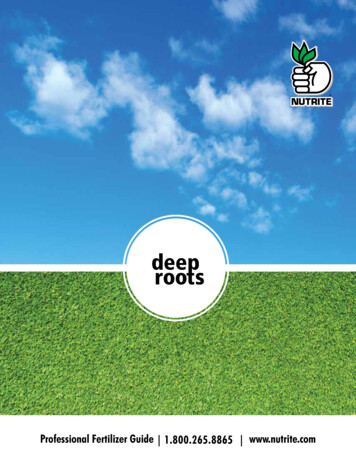
Transcription
1957L-222FERTILIZER RECOMMENDATIONSfor the Lower Rio Grande ValleySOIL AREAS:ABCDEFGHIJKEast Texas Timber CountryGulf Coast PrairieBlackland PrairieGrand PrairieWest Cross TimbersCentral BasinRio Grande PlainEdwards PlateauRolling PlainsHigh PlainsMountains and BasinsAdapted from Texas Agricultural ExperimentStation Bulletin 431, by W. T. Carter.TEXAS AGRICULTURAL· EXTENSION SERVICEG. G. Gibson, Dire-ctor, College Station, Texas
FERTILIZER RECOMMENDATIONSfor the Lower Rio Grande ValleyM. K. Thornton, Extension Agricultural ChemistW. R. Cowley, Superintendent, Substation No. 15Texas A. & M. College SystemThe fertilizer recommendations contained herein are general inscope. Soils vary in fields and area so much that soil tests should bemade in order to recommend more definite and economical fertilizer applications.For best results with fertilizers, other factors should be favorable,such as a well-prepared seed bed, good stand, absence of disease, adequate moisture, aeration and good cultural practices. Good croppingsystenls with legumes in rotation aid in a favorable response of crops tofertilizers. Where soil conditions are very favorable even higher ratesof fertilization than those shown may be economically advantageous.High-analysis fertilizers usually are cheaper. Low-analysis fertilizers cost less per bag, but the cost per acre is greater for the sameamount of nutrients. The grades, 5-10-5 and 10-20-10, have the sameratio (1-2-1) of nutrients, but 10-20-10 has twice as much fertilizingvalue as 5-10-5. It requires only one-half as many pounds of 10-20-10per acre to supply the same amount of plant nutrients.Fertilizers containing phosphorus should be drilled or plowed intothe land. Phosphorus does not move freely into the soil. Liquid fertilizers may be used instead of solid fertilizers at the same rate per acre.Liquid fertilizers usually are much more expensive per unit of nutrients.Anhydrous ammonia is an excellent source of nitrogen when properlyapplied. It is the cheapest nitrogen fertilizer when used at moderateto high rates on large acreages. When anhydrous ammonia is used asa fertilizer, the opening made by the applicator should be covered immediately to prevent loss of ammonia. Likewise, the soil should be ingood tilth.FERTILIZER RECOMMENDATIONS:The following recommendations are expressed in pounds of nutrients per acre and do not represent fertilizer grades. The nutrientsmust be obtained from materials or fertilizer mixtures sold on themarket.For example, a recommendation calling for 30-60-30, which is a1-2-1 ratio, can be obtained by applying 600 pounds of 5-10-5 or 250pounds of 12-24-12 or 300 pounds of 10-20-10. Again, if a recommendation calls for 15-60-0, this may be obtained by applying about 400 poundsof a 4-16-0 or 125 pounds of 11-48-0.
Row Crops: Fertilizer usually is applied at the time of planting orjust before. Fertilizers are more efficiently used by most crops whenapplied in a band 2 to 3 inches to the side and 2 to 3 inches below the seed.If equipment for applying fertilizers in bands while planting or cultivating is not available, apply the fertilizer in the water furrow andbed on it when the land is prepared for planting. Avoid putting the seedtoo close to the fertilizer as germination may be impaired.If large quantities of nitrogen fertilizer are to be applied, part ofthe nitrogen should be drilled into the soil with the phosphorus andpotash and the remainder applied 35 to 45 days later as a side or topdressing.Small Grains: Fertilizers for small grains may be broadcast, drilledin or plowed in. Fertilizers containing nitrogen and potash should not beallowed to touch the seed.Phosphorus, potash and part of the nitrogen should be applied ator before seeding. The rest of the nitrogen should be applied in thespring before plants begin to joint.Pastures: For establishing improved pastures, fertilizer shouldbe applied in bands when possible. Otherwise, it should be broadcast,drilled or plowed in. For maintenance, topdress with 30-0-0 as needed.Repeat basic fertilizer treatment annually as suggested or according toa soil test.Fruit Trees: Fertilizer for fruit trees may be applied over the entire area covered by the orchard when the trees are mature. In nonbearing orchards, the fertilizer should be applied over the area coveredby the spread of the limbs. Keep fertilizer 1 foot away from tree trunks.Cultivate fertilizer applications into the soil.Recommendations for fertilizers in this circular are those foundbest, by experiments, tests and practical experience in the field. Theyrange from the calcareous (limy) river valley clays to the sands of theuplands. If your farm contains both clays and loams, there will be tworecommendations for your land.When crops follow legumes turned under, the amount of fertilizerto be applied at planting may be reduced. Side or topdress with theamount of fertilizer suggested.The letters NR mean that the crop is not recommended for thisclass of soils.Cooperative Extension Work in Agriculture and Home Economics, The TexasA. & M. College System and United States Department of Agriculture cooperating.Distributed in furtherance of the Acts of Congress of May 8, 1914, as amended, andJune 30, 1914.5M-10-56, Revised.
Lower Rio Grande ValleyPOUNDS OF NUTRIENTS TO BE APPLIED PER ACRE AT OR BEFORE PLANTINGIrrigatedSandsandloamy sandsClaysandclay loamsLoamsandsandy dedress with 40-0-0 at first forms. Corn, grain sorghum40-0-060-60-060-80-0Sidedress with 60-0-0 at knee highSudan, J ohnsongrass,Oats, barley40-0-060-60-060-80-0Sidedress with 60-0-0 each time cutor grazed downAnnual legumes20-80-020-80-020-80-0Pastures (Permanent)40-80-060-80-040-80-0TRUCK CROPSSpinach, escarole, endive 40-40-0Dandelion, collards, 0-0-0 when plants begin to headBroccoli60-60-060-60-060-60-060-0-0 at 6-8 leavesLettuce40-80-040-80-060-80-060-0-0 when plants begin to headSweet corn40-0-040-40-040-80-060-0-0 when plants are knee highTomatoes40-80-040-80-040-80-040-0-0 at set of first 0-80-080-80-0Sidedress with 40-0-0 as neededPotatoes40-40-040-80-080-80-0Sidedress with 40-0-0 as neededCarrots40-40-040-80-040-80-0Sidedress with 40-0-0 as needed40-40-040-80-0Sidedress with 40-0-0 as neededFIELD CROPSAlfalfaCotton & sesameBeets, turnipsRemarksTopdress with 60-0-0 each time cutor grazed 040-80-0Beans and peas40-40-040-80-040-80-0Sidedress with 40-0-0 as neededWatermelons, cucumbers80-80-080-80-080-80-0Sidedress with 40-0-0Cantaloupes40-80-040-80-080-80-0Sidedress with 40-0-0 as needed1-0-01-0-01-0-0In 2 or 3 applications. If 2-Jan. andSept. If 3-Jan., May and Sept.Bearing trees, 5-10 yrs. old 2-0-02-0-02-0-0In 2 or 3 applications. If 2-Jan. andSept. If 3-Jan., May and Sept.Old trees, over 10 yrs. old 3-0-03-0-03-0-0In 2 or 3 applications. If 2-Jan.and Sept. If 3-Jan., May and Sept.CITRUS-Per treeyoung trees, 5 years oldac;needed
Dry Land30-60-030-60-030-60-030-0-0 at first forms, if soil moistureis adequateCorn, grain sorghum20-0-020-60-030-60-030-0-0 in 35 days if soil moisture isadequateAnnual legumes20-60-020-80-020-80-0Pastures (Permanent)40-80-040-80-040-80-0PasturesOats and Sudan60-60-060-60-060-60-0Topdress with 30-0-0 each time cutor grazed down if soil moisture -0-040-0-040-0-0Sidedress with 40-0-0 if soil moisture is adequateCantaloupes, cucumbers40-80-040-80-080-80-0Sidedress with 40-0-0 at first bloomif soil moisture is ELD CROPSCottonTRUCK CROPSBeans, peasWatermelonsTopdress with 30-0-0 each time cutor grazed down if soil moisture isadequateSidedress with 40-0-0 at first bloomif soil moisture is adequate
Lower Rio Grande Valley POUNDS OF NUTRIENTS TO BE APPLIED PER ACRE AT OR BEFORE PLANTING Irrigated Clays Loams Sands and and and Remarks clay loams sandy loams loamy sands FIELD CROPS Alfalfa 20-80- 20-80- 20-100- Cotton & sesame 40-80- 40-80- 40-80- Sidedress with 40-0-0atfirst forms. Corn, grain sorghum 40-0-0 60-60- 60-80- Sidedress .











